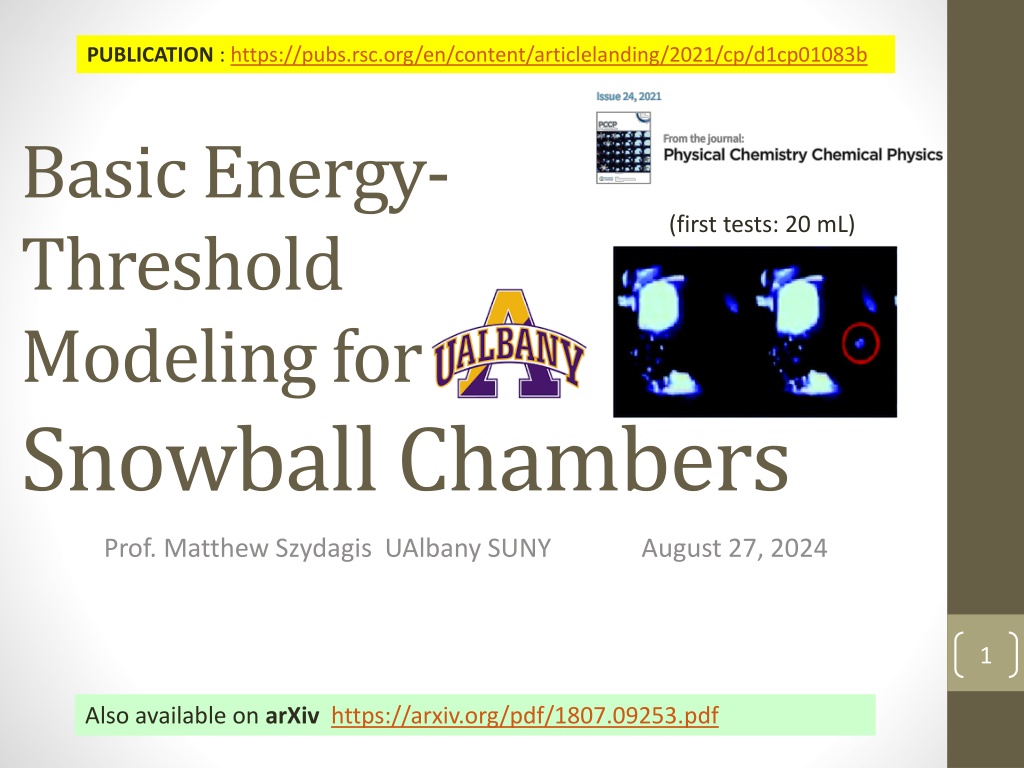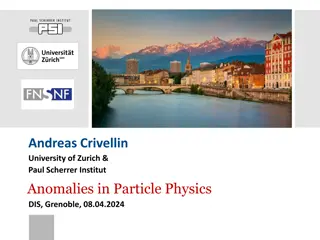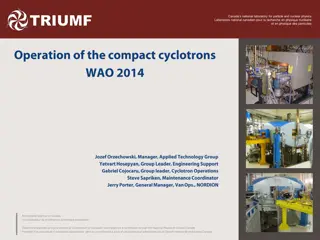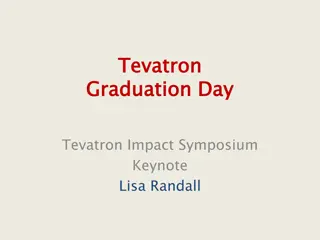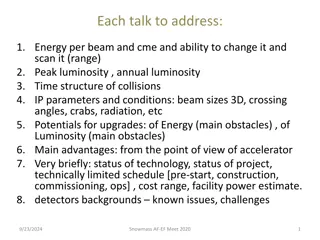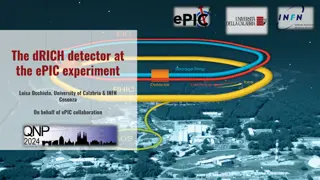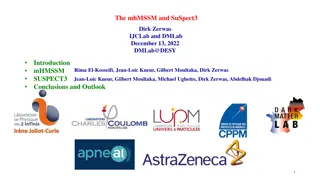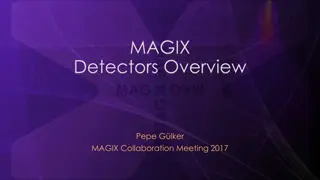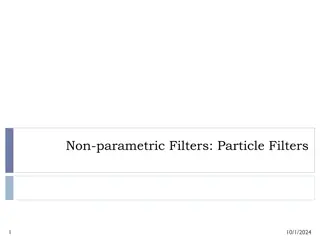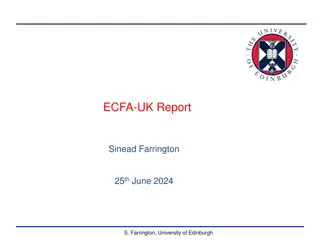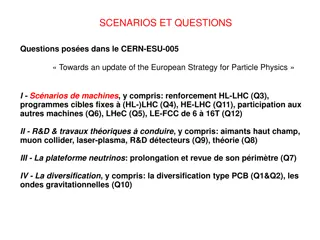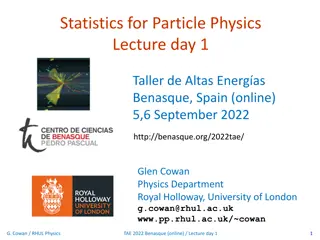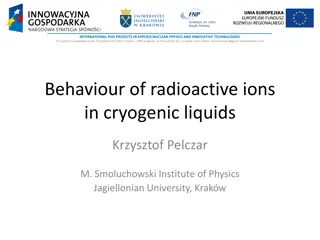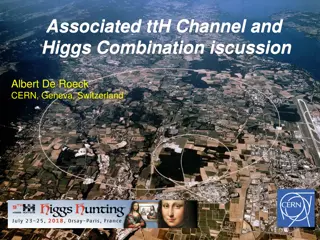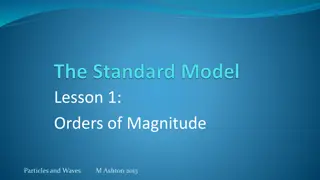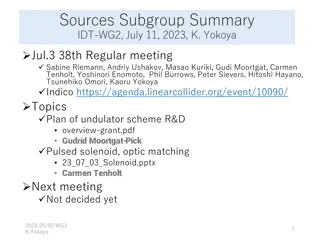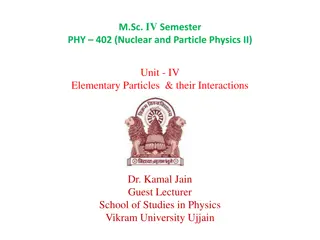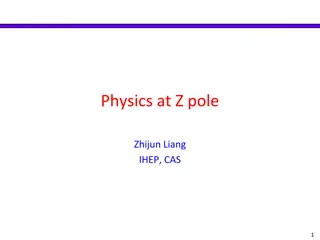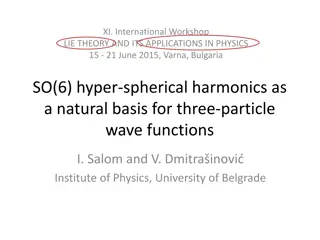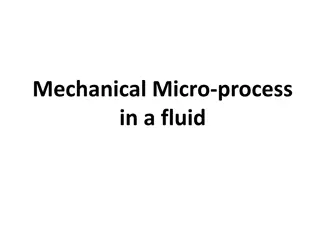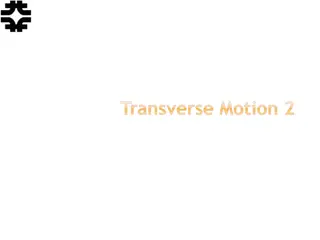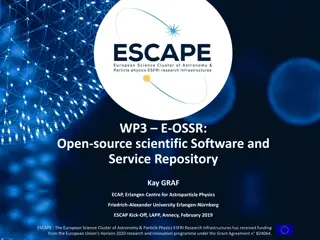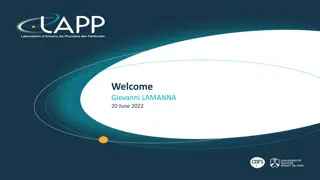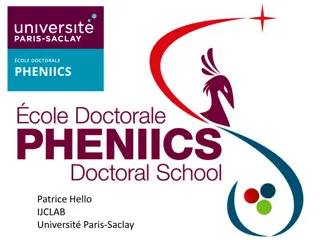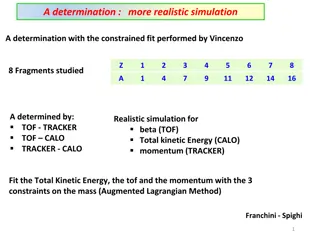Exploring Snowball Chambers in Particle Physics
Snowball chambers, a new instrument in nuclear and particle physics, resemble bubble and cloud chambers but operate based on supercooling pure water to study phase transitions. This innovative tool offers advantages such as scalability, purity, and safety, making it ideal for dark matter research and energy reconstruction in detecting nuclear recoils. Recent tests have shown promising results in freezing supercooled water with neutrons, opening new possibilities for detecting sub-keV energy levels.
Download Presentation

Please find below an Image/Link to download the presentation.
The content on the website is provided AS IS for your information and personal use only. It may not be sold, licensed, or shared on other websites without obtaining consent from the author. Download presentation by click this link. If you encounter any issues during the download, it is possible that the publisher has removed the file from their server.
E N D
Presentation Transcript
PUBLICATION : https://pubs.rsc.org/en/content/articlelanding/2021/cp/d1cp01083b Basic Energy- Threshold Modeling for Snowball Chambers (first tests: 20 mL) Prof. Matthew Szydagis UAlbany SUNY August 27, 2024 1 Also available on arXiv https://arxiv.org/pdf/1807.09253.pdf
What is a Snowball Chamber? done before, but only with betas and gammas, most recently by Varshneya (Nature, 1971) Physics Dept., Univ. of Roorkee, India The snowball chamber is analogous to the bubble & cloud chambers It also relies on a phase transition But it is a new instrument in nuclear & particle physics Supercooling of pure water in clean, smooth containers Although, as with bubble chambers almost any other liquid should be usable A liquid such as water can be cooled below its normal freezing point. Metastability CO-INVENTED w/ _Prof Cecilia Levy 2
Dark Matter: A Lamppost Effect (or, streetlight) Snowmass 2013 (older version chosen on purpose) WIMPs (Weakly Interacting Massive Particles) still well motivated 3
The Advantages and The Merits Scalability: project examples (H2O Cherenkov detectors) Either in bulk or modular (many small tubes) OR in droplet form Purity: water is cheap and easy to purify. Done regularly We ve used a 20nm filter. Can upgrade to 5 but also try 100 (speed) No cryogenics (-30 C isn t very cold) nor high voltage necessary In general, excellent safety: no superheated liquid for instance The lightest possible element to search for the lightest dark matter still producing nuclear recoils: Hydrogen Plus sensitivity to medium-mass dark matter with Oxygen Possible recoil differentiation with AI/ML (more on this later) Lower neutrino fog for hydrogen than other elements WHY possible? H bonding Directionality, the holy grail of dark matter direct detection In the bulk of a liquid, not in gas. For rejecting solar s Energy reconstruction: last summer we demonstrated the supercooling of WbLS (water-based liquid scintillator). A first! https://www.mdpi.com/2218-1997/10/2/81 4
Critical Proof of Concept (2018) Neutrons (252Cf) are able to freeze supercooled water A world first. Made the journal cover (see slide 1) Yet another advantage: neutrons will multiply scatter in water (with a few-cm mean free path) Won t mistake for WIMP Observed in cam (slide 1) Our first results are consistent with keV-scale energy threshold Theory papers suggest sub-keV very possible Cf corroborated by AmBe higher temp (AND shorter time) Shift does NOT seem to happen with gammas Cf-252 Control arXiv:2401.15064 5 20 g
Comparison of (Geant4) Simulations with the Data Stopping power spectra for each possible type of recoil. Corresponding initial species Es for which this is the mean dE/dx are along upper x-axes. A 100 MeV/cm threshold assumption explains a lack of discernible response from a source (Inset) Geant4 geometry: cross-sectional view 6
(1) Critical Energy and Radius (2) 7 (3) (4)
What are the Backgrounds? Promises of dark matter search results without an understanding of backgrounds cannot be trusted. Cosmic-ray muons: minimize flux by going underground and adding shielding (either active or passive) Neutrons: covered (neutrinos also covered) Beta and gammas (e- recoils): adjust temperature to avoid them, and make experiment out of low-background materials Alphas: purify water, use timing as in PICO, use piezo-electric acoustic sensors as in PICO, adjust temperature to avoid (so we have plans A, B, C, D). Colder = lower energy, dE/dx thresholds The Wall: fiducialization, smooth vessels sourced from same suppliers as used for bubbler chambers, hydrophobic materials, super-hydrophobic coatings (again, multiple backup plans) Spontaneous bulk nucleation: perhaps no such thing! But!! optimize T just in case (Goldilocks). Go modular. Vibration iso 8
Projected WIMP Sensitivities plots from DoE Cosmic Visions Report (arXiv:1707.04591) with our own curves overlaid. No directionality assumed No past, present, future (planned) experiment has comparable sensitivity at 1 GeV for WIMP-proton coupling (spin-dependent) That is true even if the energy threshold is > 1 keVnr not lower value Readiness: need O(4) yr. at least for calibrations + optimizations Conservative = 1 kg-year live exposure -> e.g. only 1 kg for 1 year undergroun d! Aggressive = 100 kg-years Conservative Aggressive SI (left) spin- independent SD-proton spin- dependent (right plot) 9
The Future Calibrate with mono-energetic neutron beam (e.g. TUNL, but UAlbany also has beam) at different Ts, n fluxes, n Es, etc. Goal: become the first dark matter experiment to deploy 2 detectors, one in the Northern and one in the Southern Hemisphere, to study annual modulation and disprove false positives trivially AGILE! While scale up would be nice, already competitive at O(1 kg) scale, so emphasis on LONG-TERM stable running If underground and away from cosmic rays, we will not even need to solve major challenge from surface of the melting time Made it into Snowmass reports (and P5/HEPAP spoke highly of small-project funding) 10
Concluding with Sample Videos The snowball chamber captures the imagination like few other experiments can *PUBLIC ENGAGEMENT* These are the most recent videos, from BNL (sabbatical) FLIR (low FPS) and high-speed camera (6,000 FPS example) FLIR.mov ~15 second start Evt14BNL.mp4 (both too large to embed) ~half-way through 11
